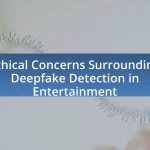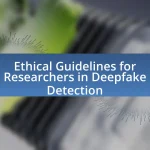The article examines the ethical challenges associated with cross-border deepfake detection, focusing on issues of privacy, consent, and jurisdiction. It highlights the potential for misinformation and manipulation across different legal frameworks, complicating accountability for deepfake creators. The discussion includes the impact of cultural differences on ethical perceptions, the implications for privacy rights, and the need for international cooperation to establish effective detection methods. Additionally, it addresses the technical challenges in detecting deepfakes and outlines best practices for ethical detection, emphasizing the importance of transparency, accountability, and public education.
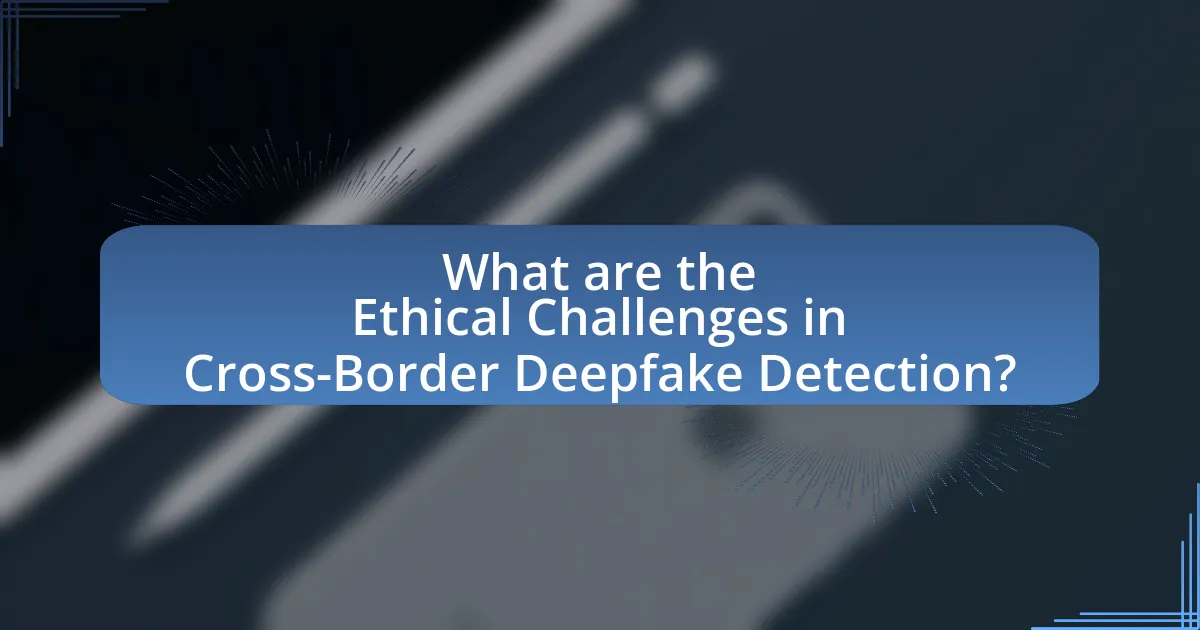
What are the Ethical Challenges in Cross-Border Deepfake Detection?
The ethical challenges in cross-border deepfake detection primarily involve issues of privacy, consent, and jurisdiction. Privacy concerns arise when individuals’ images or voices are manipulated without their knowledge or approval, leading to potential harm and reputational damage. Consent is critical, as the creation and distribution of deepfakes often occur without the explicit permission of the individuals depicted, raising ethical questions about ownership and rights over one’s likeness. Jurisdictional challenges complicate enforcement, as laws governing deepfake technology vary significantly across countries, making it difficult to hold perpetrators accountable. These factors collectively create a complex ethical landscape that complicates the detection and regulation of deepfakes on a global scale.
Why is Cross-Border Deepfake Detection an Ethical Concern?
Cross-border deepfake detection raises ethical concerns primarily due to the potential for misinformation and manipulation across different jurisdictions. The use of deepfakes can lead to significant harm, including defamation, political interference, and erosion of trust in media, as evidenced by incidents where manipulated videos have influenced elections or public opinion. Furthermore, the lack of consistent legal frameworks across countries complicates accountability, making it difficult to address the misuse of deepfake technology effectively. This inconsistency can result in varying standards of what constitutes ethical use, leading to exploitation in regions with weaker regulations.
What ethical dilemmas arise from the use of deepfakes across borders?
The use of deepfakes across borders raises significant ethical dilemmas, primarily concerning misinformation, consent, and accountability. Misinformation can lead to political instability, as deepfakes may be used to manipulate public opinion or interfere in elections, evidenced by instances where altered videos have been employed to discredit political figures. Consent issues arise when individuals’ likenesses are used without permission, violating personal rights and privacy, as seen in cases where celebrities have been targeted for non-consensual deepfake pornography. Accountability becomes complex in cross-border scenarios, as jurisdictional challenges hinder the prosecution of those who create harmful deepfakes, leading to a lack of legal recourse for victims. These dilemmas highlight the urgent need for international regulations and ethical guidelines to address the implications of deepfake technology.
How do cultural differences impact ethical perceptions of deepfake technology?
Cultural differences significantly impact ethical perceptions of deepfake technology by shaping societal norms and values regarding authenticity and deception. For instance, in collectivist cultures, such as those in East Asia, the emphasis on community and harmony may lead to a more critical view of deepfakes as tools that disrupt social trust. Conversely, in individualistic cultures, like those in the United States, there may be a greater acceptance of deepfakes as a form of creative expression or entertainment, despite potential ethical concerns. Research indicates that cultural context influences how individuals interpret the intent and consequences of deepfake use, with studies showing that perceptions of harm and deception vary widely across different cultural backgrounds. This divergence in ethical viewpoints complicates the establishment of universal standards for deepfake technology, highlighting the need for culturally sensitive approaches in cross-border detection and regulation.
What are the implications of deepfake technology on privacy rights?
Deepfake technology significantly undermines privacy rights by enabling the creation of realistic but fabricated audio and visual content that can misrepresent individuals without their consent. This manipulation can lead to unauthorized use of a person’s likeness, potentially resulting in reputational harm, emotional distress, and financial loss. For instance, a study by the Brookings Institution highlights that deepfakes can be weaponized for harassment or defamation, raising concerns about the erosion of personal privacy and the difficulty in controlling one’s image in the digital realm. Furthermore, the lack of regulatory frameworks to address these issues exacerbates the risks, leaving individuals vulnerable to exploitation and misuse of their personal data.
How does deepfake technology challenge individual privacy in different jurisdictions?
Deepfake technology challenges individual privacy by enabling the creation of realistic but fabricated audio and visual content that can be used to impersonate individuals without their consent. This capability raises significant legal and ethical concerns across different jurisdictions, as laws regarding privacy, defamation, and consent vary widely. For instance, in the European Union, the General Data Protection Regulation (GDPR) provides strong protections for personal data, which can be violated by deepfake creations, while in the United States, the legal framework is less uniform, leading to potential gaps in privacy protection. Furthermore, the cross-border nature of the internet complicates enforcement, as a deepfake created in one jurisdiction may impact individuals in another, highlighting the need for international cooperation and harmonization of privacy laws to address these challenges effectively.
What legal frameworks exist to protect privacy against deepfakes?
Legal frameworks that protect privacy against deepfakes include existing laws on defamation, copyright, and privacy rights, as well as emerging legislation specifically targeting deepfakes. For instance, several U.S. states, such as California and Texas, have enacted laws that criminalize the malicious use of deepfakes, particularly in contexts like election interference and non-consensual pornography. These laws aim to safeguard individuals’ privacy by imposing penalties on those who create or distribute deepfakes without consent. Additionally, the European Union’s General Data Protection Regulation (GDPR) provides a broader framework for data protection, which can be applied to deepfake technology when it involves personal data. This regulatory environment is evolving to address the unique challenges posed by deepfakes, ensuring that privacy rights are upheld in the digital landscape.
How does misinformation relate to ethical challenges in deepfake detection?
Misinformation significantly complicates ethical challenges in deepfake detection by undermining trust in media and creating dilemmas regarding privacy and consent. The proliferation of deepfakes, which can easily spread false narratives, raises ethical concerns about the potential for harm to individuals and society, as seen in cases where manipulated videos have led to reputational damage or incited violence. Furthermore, the difficulty in distinguishing between genuine and altered content can lead to unjust consequences, such as wrongful accusations or censorship, highlighting the need for robust detection methods that respect ethical standards. Studies indicate that 85% of individuals struggle to identify deepfakes, emphasizing the urgency for ethical frameworks that address both the technology’s capabilities and its societal implications.
What role do deepfakes play in the spread of misinformation globally?
Deepfakes significantly contribute to the spread of misinformation globally by creating hyper-realistic but fabricated audio and video content that can mislead audiences. This technology enables the manipulation of public figures’ appearances and statements, making it difficult for viewers to discern truth from fiction. For instance, a study by the University of California, Berkeley, found that deepfake videos can influence viewers’ perceptions and beliefs, leading to the potential for widespread misinformation campaigns. The ease of access to deepfake creation tools further exacerbates this issue, allowing malicious actors to produce and disseminate misleading content rapidly across social media platforms, thereby undermining trust in legitimate information sources.
How can ethical guidelines help mitigate misinformation caused by deepfakes?
Ethical guidelines can help mitigate misinformation caused by deepfakes by establishing standards for the responsible creation and dissemination of digital content. These guidelines promote transparency, requiring creators to disclose when content has been altered or generated using deepfake technology, which can reduce the likelihood of misleading audiences. For instance, the European Union’s proposed regulations on artificial intelligence emphasize the need for clear labeling of synthetic media, thereby fostering accountability among content creators. By enforcing such ethical standards, stakeholders can create a framework that discourages malicious use of deepfakes, ultimately protecting public trust in media.
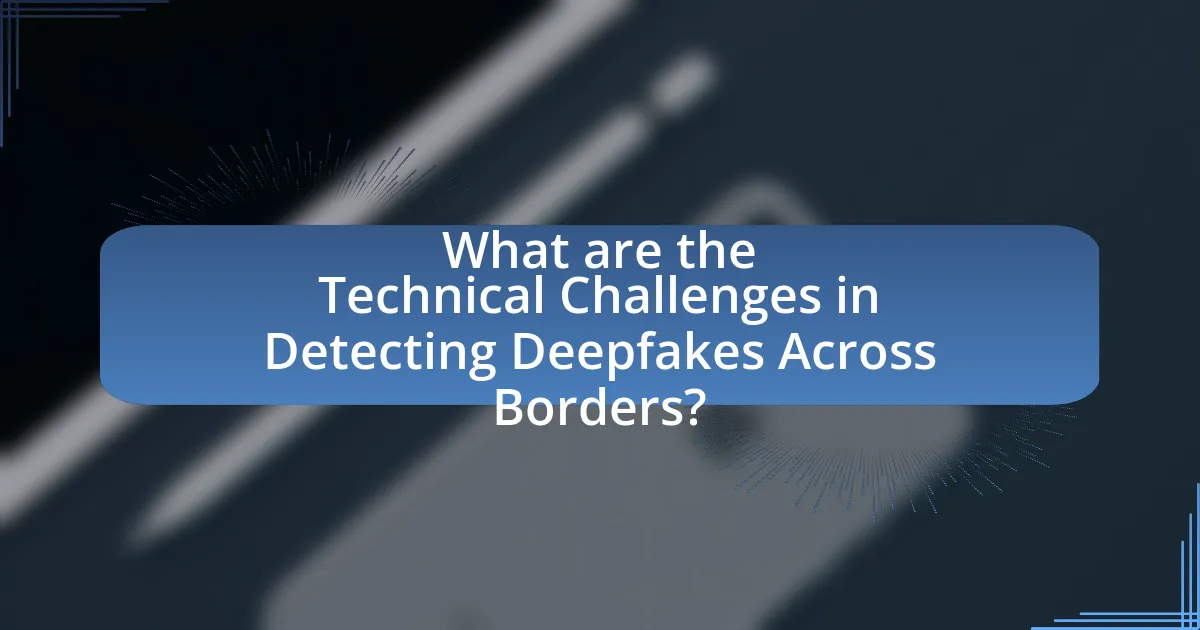
What are the Technical Challenges in Detecting Deepfakes Across Borders?
The technical challenges in detecting deepfakes across borders include variations in data quality, differing legal frameworks, and the need for advanced algorithms that can adapt to diverse cultural contexts. Variations in data quality arise because deepfake detection systems often rely on training data that may not represent the specific characteristics of media from different regions. Additionally, differing legal frameworks complicate the enforcement of detection technologies, as regulations on privacy and data usage vary significantly between countries. Furthermore, advanced algorithms must be developed to account for cultural nuances in media consumption and production, which can affect the effectiveness of detection methods. These challenges highlight the complexity of implementing consistent and reliable deepfake detection across international boundaries.
How do technological limitations affect deepfake detection?
Technological limitations significantly hinder deepfake detection by restricting the effectiveness of existing detection algorithms. Current detection methods often struggle to keep pace with the rapid advancements in deepfake creation technologies, which utilize sophisticated machine learning techniques to produce highly realistic content. For instance, a study published in 2020 by Korshunov and Marcel demonstrated that state-of-the-art deepfake detection systems could only achieve around 65% accuracy on high-quality deepfakes, indicating a substantial gap in reliability. This discrepancy arises from the evolving nature of deepfake generation tools, which continuously improve their ability to mimic human features and expressions, making it increasingly difficult for detection systems to identify manipulated media accurately.
What are the current methods used for deepfake detection?
Current methods used for deepfake detection include machine learning algorithms, digital forensics techniques, and blockchain technology. Machine learning algorithms, particularly convolutional neural networks (CNNs), analyze visual and audio inconsistencies in deepfake content, achieving high accuracy rates in identifying manipulated media. Digital forensics techniques examine metadata and pixel-level anomalies, providing insights into the authenticity of videos. Blockchain technology offers a decentralized approach to verify the origin and integrity of media files, ensuring that any alterations can be traced. These methods are supported by research indicating their effectiveness, such as a study published in the IEEE Transactions on Information Forensics and Security, which highlights the success of CNNs in detecting deepfakes with over 90% accuracy.
How effective are these methods in different cultural contexts?
The effectiveness of methods for deepfake detection varies significantly across different cultural contexts due to differences in media consumption, technological access, and legal frameworks. For instance, in cultures with high digital literacy and robust legal protections against misinformation, such as in many Western countries, detection methods tend to be more effective because users are more aware of deepfake technology and its implications. Conversely, in regions with limited access to technology or lower awareness of digital media manipulation, such as in some developing countries, these methods may be less effective, as individuals may not recognize deepfakes or have the tools to verify content. Studies indicate that cultural attitudes towards technology and trust in media also influence the effectiveness of detection methods, highlighting the need for tailored approaches that consider local contexts and educational initiatives to enhance awareness and understanding of deepfake risks.
What role does international collaboration play in deepfake detection?
International collaboration is crucial in deepfake detection as it enables the sharing of resources, expertise, and data across borders to combat the global threat posed by deepfakes. This collaboration allows countries to develop standardized detection technologies and methodologies, enhancing the effectiveness of identifying manipulated media. For instance, initiatives like the Deepfake Detection Challenge, supported by organizations such as Facebook and the Partnership on AI, demonstrate how collaborative efforts can lead to improved algorithms and tools for detecting deepfakes. Furthermore, international partnerships facilitate the establishment of legal frameworks and best practices, ensuring a coordinated response to the ethical challenges posed by deepfakes across different jurisdictions.
How can countries work together to improve detection technologies?
Countries can work together to improve detection technologies by establishing international collaborations focused on research, sharing best practices, and developing standardized protocols. Collaborative initiatives, such as joint research projects funded by organizations like the European Union or the United Nations, can facilitate the exchange of knowledge and resources. For instance, the Global Partnership on Artificial Intelligence promotes international cooperation in AI, which includes enhancing detection technologies for deepfakes. Additionally, countries can create forums for sharing data and algorithms, enabling the development of more robust detection systems. This collaborative approach is essential, as deepfake technology transcends borders, necessitating a unified response to effectively combat its misuse.
What are the challenges of sharing data and resources internationally?
The challenges of sharing data and resources internationally include legal barriers, differing regulations, and concerns over privacy and security. Legal barriers arise from varying national laws that govern data protection, such as the General Data Protection Regulation (GDPR) in Europe, which imposes strict rules on data transfer. Differing regulations can lead to complications in compliance, as countries may have contrasting standards for data usage and sharing. Additionally, privacy concerns are heightened when sensitive information crosses borders, leading to fears of misuse or unauthorized access. Security issues also emerge, as international data sharing increases the risk of cyberattacks and data breaches, complicating trust among parties involved.
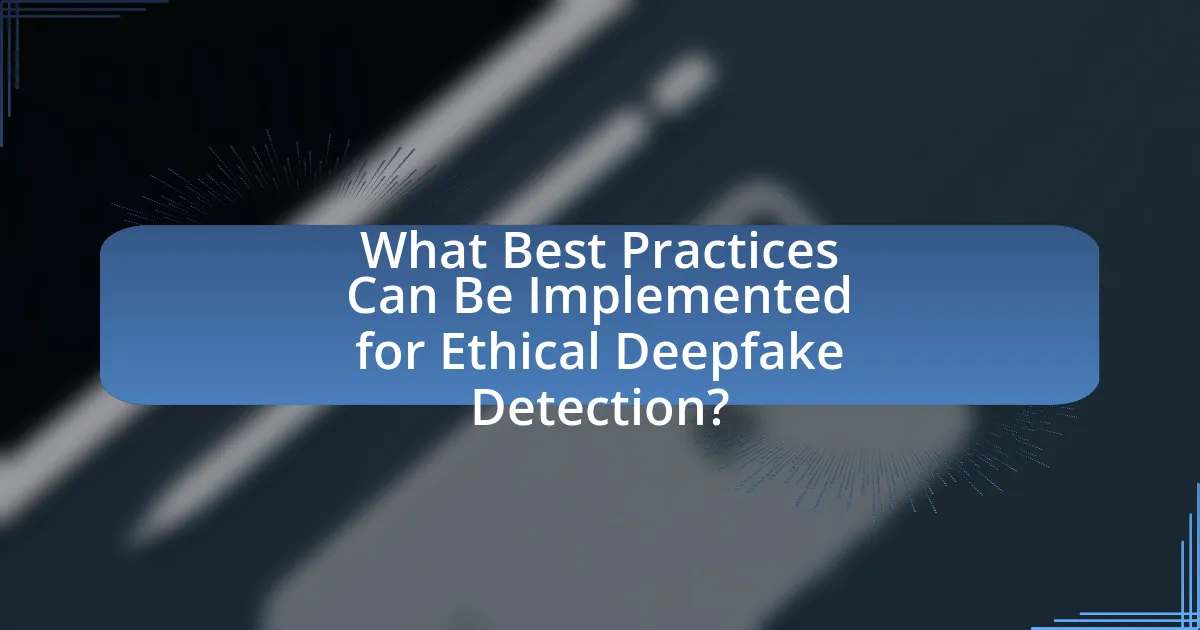
What Best Practices Can Be Implemented for Ethical Deepfake Detection?
Best practices for ethical deepfake detection include the development of robust detection algorithms, transparency in the detection process, and collaboration among stakeholders. Robust detection algorithms utilize machine learning techniques to identify inconsistencies in deepfake content, such as unnatural facial movements or audio mismatches. Transparency ensures that users understand how detection tools work and the criteria used for identifying deepfakes, fostering trust in the technology. Collaboration among stakeholders, including technology companies, policymakers, and researchers, is essential for sharing knowledge and resources, as highlighted by the Partnership on AI’s guidelines for responsible AI use. These practices collectively enhance the effectiveness and ethical standards of deepfake detection efforts.
How can organizations develop ethical guidelines for deepfake detection?
Organizations can develop ethical guidelines for deepfake detection by establishing a framework that prioritizes transparency, accountability, and user consent. This framework should include clear definitions of deepfakes, the potential harms they pose, and the ethical implications of their use. For instance, the European Union’s proposed regulations on artificial intelligence emphasize the need for risk assessments and transparency in AI applications, which can serve as a model for organizations. Additionally, involving stakeholders, including legal experts, ethicists, and affected communities, in the guideline development process ensures diverse perspectives are considered, enhancing the guidelines’ relevance and effectiveness.
What key principles should be included in these guidelines?
Key principles that should be included in guidelines for ethical challenges in cross-border deepfake detection are transparency, accountability, and fairness. Transparency ensures that the processes and technologies used in deepfake detection are clear and understandable to stakeholders, which builds trust and allows for informed consent. Accountability mandates that individuals and organizations involved in the detection process are responsible for their actions and decisions, fostering ethical practices. Fairness emphasizes the need to avoid bias in detection algorithms, ensuring that all individuals are treated equitably regardless of their background. These principles are essential to address the ethical implications of deepfake technology and to promote responsible usage across borders.
How can organizations ensure compliance with ethical standards?
Organizations can ensure compliance with ethical standards by implementing comprehensive ethical guidelines and training programs. Establishing a clear code of ethics that outlines acceptable behaviors and decision-making processes is essential. Regular training sessions for employees on ethical practices, particularly in the context of emerging technologies like deepfakes, help reinforce these standards. Additionally, organizations should conduct regular audits and assessments to evaluate adherence to ethical guidelines, ensuring accountability and transparency. Research indicates that companies with strong ethical cultures experience fewer legal issues and improved employee morale, highlighting the importance of proactive compliance measures.
What strategies can be employed to educate the public about deepfakes?
To educate the public about deepfakes, implementing comprehensive awareness campaigns is essential. These campaigns can utilize social media platforms, educational institutions, and community workshops to disseminate information about the nature of deepfakes, their potential risks, and how to identify them. Research indicates that 86% of people are unaware of deepfake technology, highlighting the need for targeted educational efforts (Source: Deepfake Detection Challenge, 2020). Additionally, collaboration with tech companies to develop user-friendly tools for detecting deepfakes can empower individuals to critically assess media content.
How can awareness campaigns effectively inform individuals about deepfake risks?
Awareness campaigns can effectively inform individuals about deepfake risks by utilizing targeted messaging, educational resources, and real-world examples. Targeted messaging ensures that the information reaches specific demographics that are more likely to encounter deepfakes, such as social media users and content creators. Educational resources, including workshops and online courses, can provide individuals with the skills to identify deepfakes, enhancing their media literacy. Real-world examples of deepfake incidents, such as the 2018 deepfake of actor Bill Hader morphing into Tom Cruise, illustrate the potential dangers and consequences of deepfakes, making the risks more tangible. Research indicates that campaigns that combine these strategies can significantly increase awareness and understanding of deepfake technology and its implications, as evidenced by studies showing improved recognition of manipulated media among participants after exposure to educational content.
What role do educational institutions play in combating deepfake misinformation?
Educational institutions play a crucial role in combating deepfake misinformation by providing education and training on digital literacy and critical thinking. These institutions develop curricula that teach students how to identify and analyze deepfake content, fostering an understanding of the technology behind it and its implications. For instance, programs in media studies and computer science often include modules on misinformation, equipping students with the skills to discern credible sources from manipulated media. Research indicates that educational initiatives can significantly enhance individuals’ ability to detect deepfakes, as demonstrated by studies showing that trained individuals are more adept at recognizing altered videos compared to those without such training.
What are the practical steps for individuals to protect themselves from deepfakes?
Individuals can protect themselves from deepfakes by verifying the authenticity of media before sharing or believing it. This can be achieved through several practical steps:
- Use reverse image search tools to check the origin of images or videos.
- Look for inconsistencies in the content, such as unnatural facial movements or mismatched audio.
- Rely on reputable news sources and fact-checking websites to confirm the validity of suspicious content.
- Educate oneself about the technology behind deepfakes to better recognize potential fakes.
- Utilize software tools designed to detect deepfakes, which are increasingly available to the public.
These steps are essential as deepfakes can manipulate perceptions and spread misinformation, making vigilance crucial in today’s digital landscape.

